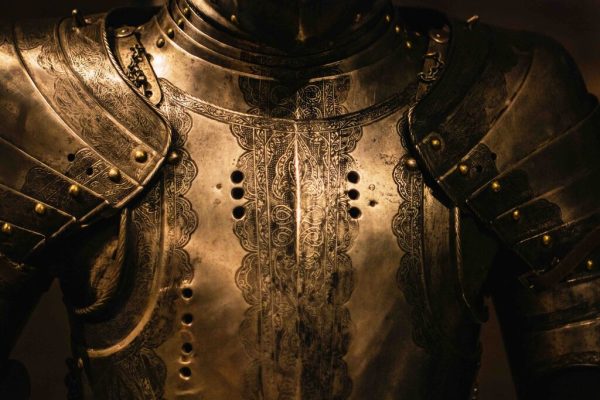Home>Christian Resources>The Hard Facts About Satanic Ritual Abuse


Christian Resources
The Hard Facts About Satanic Ritual Abuse
Published: December 3, 2019
Satanic worshipers are real! Here are TRUE stories of satanic ritual abuse evolutions & how you can understand what makes a crime Satanic & Ritualistic.
(Many of the links in this article redirect to a specific reviewed product. Your purchase of these products through affiliate links helps to generate commission for Christian.net, at no extra cost. Learn more)
Christian Research Institute Journal
The Hard Facts About Satanic Ritual Abuse
by Bob and Gretchen Passantino
from the Christian Research Journal, Winter 1992, page 20. The Editor-in-Chief of the Christian Research Journal is Elliot Miller.
A teenage girl, who was impregnated during a satanic ritual, is forcibly delivered of her near term baby and then made to ritually kill the child and eat its heart as cult members watch. Another girl, a small child, is sewn inside the cavity of a disemboweled animal and “rebirthed” by her cultic captors in a grotesque ceremony. A preschool class is systematically abused — sexually, emotionally, and physically — by members of a nationwide, nearly invincible network of satanic pedophiles and pornographers. A young girl is thrown into an electrified cage with wolves and ritually tortured to deliberately produce a “wolf personality,” part of her multiple personality disorder (MPD; see glossary).
These are but a few of the thousands of horrifying stories circulating throughout the United States and abroad.[1] Some true believers (see glossary) in satanic ritual abuse (SRA) say that more than 100,000 “adult survivors” have undergone therapy and “remembered” these horrible abuses.[2] Others more than double this number.[3] These terrifying accounts are linked to the current public concern about child abductions by strangers, which true believers claim number in the thousands annually.[4] True believers say the conspiracy[5] is almost invincible, covers the nation (if not the world), and involves key power players in the courts, education, politics, religion, and society in general.
True believers provide unconditional support to alleged adult survivors whose therapeutically recovered “memories” typically implicate their elderly parents in heinous crimes including murder, cannibalism, sexual torture, incest, and bestiality. Some alleged victims bring their cases to law enforcement officials, hoping for criminal prosecution. Some obtain restraining orders barring their parents from seeing them or their grandchildren. Some cut all ties with family and simply disappear. A few begin new lives as television and radio talk show guests, sharing their gruesome stories from coast to coast during after-school television time. Almost all are in the midst of long-term, intensive therapeutic counseling. Many undergo dozens of psychiatric hospitalizations and take part in almost daily therapy sessions and support group meetings. Tragically, small children are sometimes snatched from their parents’ custody on the whisper of a suspicion that the parents may be SRA participants.[6]
True believers among therapists, alleged adult survivors, law enforcement officials, journalists, and Christian leaders unanimously call for the public to believe the stories, to change the justice system so recovered “memories” alone can bring convictions in criminal court, and to rise up against this astonishingly powerful satanic conspiracy.
If the alleged victims’ allegations are true, then such reactions are to be expected. If they are false, then countless families and reputations are being destroyed for nothing, truth is being ignored, biblical standards of evidence and testimony are being discarded, “survivors” are being trapped in long-term, destructive therapeutic situations, and Satan is getting more credit than he is due. In this article, we will move beyond sensationalism and emotionalism to take a serious look at SRA stories and theories.[7]
Glossary
abreaction: In therapy, the process of “reliving” a previously repressed traumatic event as a step in integrating a dissociative personality.
adult survivor: An adult presumed to have survived and escaped from the control and abuse of a satanic cult, especially one who has “recovered” repressed memories of such abuse, usually in directive therapy settings.
directive therapy: Any form of counseling, therapy, or support group interaction that knowingly or unknowingly directs, suggests, leads, or persuades the client to adopt the therapist’s ideas, beliefs, presuppositions, or presumptions. Obvious directive therapy such as hypnotic suggestion is easy to detect. Directive therapy can be as subtle as a meaningful silence, a nod of approval, or an assurance that the client is “believed.”
dissociative state: A general category of psychological dysfunction wherein a complex pattern of psychological processes function independently of the core personality. Several dissociative conditions are clinical hysteria, amnesia, schizophrenia, and multiplicity (MPD).
multiple personality disorder (MPD): A dissociative state in which the integrated personality fragments (usually as a result of extreme trauma) into two or more “personalities,” each of which manifests a relatively complete complex of personal attributes and often acts independently and unknown to the other fragments.
occult crime: Any crime or alleged crime with some connection to the occult; ranging from rebellious teenagers who spray-paint occult graffiti to serial killers who use occult symbology or claim a commitment to occult belief.
paranoia: Clinically, paranoia is characterized by highly systematized, persistent, incapacitating delusions of persecution and/or grandeur; commonly used to describe hypervigilence over a (mis)perceived threat, belief that danger is everywhere, and believe that those who do not recognize the threat are evil and part of the threat themselves.
satanic ritual abuse (SRA): The preferred term referring to charges that a group of individuals, assumed to be in association with a widespread conspiracy, practice physical, emotional, and spiritual abuse on unwilling victims in a ritualistic manner, especially in connection with a commitment to Satanism. This is distinguished from loner or isolated small group abuse.
support group: For the purposes of this article, any group of fellow-sufferers of a similar emotional or physical trauma (or alleged trauma) meeting regularly to provide emotional and friendship support as well as advice and encouragement to each other.
true believer: For the purposes of this article, someone who is committed to believing the SRA conspiracy world view, and who often is an outspoken proponent, such as a true believer therapist, law enforcement person, parent, adult survivor, and so on.
THE HISTORY OF SRA REPORTS[8]
Until the early 1980s, law enforcement officials, the media, religious researchers, and sociologists recognized four main categories of contemporary Satanism: (1) teenage self-styled, or dabblers; (2) adult self-styled; (3) religious or public; and (4) small group.[9] Before this time, the idea of a widespread, almost invincible, multi-generational satanic conspiracy was not entertained any more seriously than ideas of UFO abduction conspiracies. During the early 1980s, however, several factors combined to provide fertile ground for the growth of SRA reports.
First, cohabitation and divorce rates skyrocketed, producing fragmented family units, single-parent families, families “blended” by divorce and remarriage, and many families with no daytime adult supervision of children. This situation provided pressure toward dysfunctional behavior (e.g., neglect, abuse, incest) in intact families. It also created the setting in broken families for a significant rise in custody disputes, child abandonment, spouse and even child accusations against the nonsupportive spouse, and other manipulative actions.[10]
Second, in the eyes of many people, the mental health community became an authoritative “discerner” of truth. This community also expanded during those years to include many different kinds of counselors, including licensed therapists, social workers, lay counselors, peer counselors, support group members and leaders, and pastoral counselors, as well as psychiatrists and psychologists. Many people assumed that any of these counselors, no matter what their training, should invariably be able to tell if a client is telling the truth.[11]
Third, an increased interest in women’s rights issues and in religious activism caused a greater awareness of, and vigorous opposition to, both pornography and the physical and sexual abuse of children. While women’s rights advocates and evangelical activists frequently opposed each other’s goals and beliefs, they united to protect the victims of pornography and child abuse. This heightened concern generated special interest groups and experts who — usually with the best of intentions — still needed to find a danger of sufficient depth and breadth to warrant large commitments of time, legislation, and funding for their causes.[12]
Fourth, a significant segment of American evangelicalism developed a complex satanic end-times view, combining the 1970s “deliverance” ministries with “newspaper prophecy” theology. While the end-times speculators of the 1970s pointed primarily at the rebirth of the nation of Israel as a sign that Christ’s Second Coming was near, the speculators of the 80s also emphasized the rise of destructive occult activity as a sign that the end was imminent.[13] In Mike Warnke’s testimony of his purported former involvement with Satanism, The Satan Seller, he claimed that in 1965 he led a group of 1,500 Satanists in a desert area of Southern California, and that he was “part of a deep and widespread organization, operating not only in the U.S., but all over the world.”[14]
Each of these four developments — family disintegration, diffusion in the mental health community, activist opposition to victimization, and an evangelical expectation of increasing occult activity — provided the nutrients for the development of SRA reports in the 1980s. The first publicized case was that of Michelle Smith. An emotionally dysfunctional woman at the time, Smith claimed to discover — with the help of her therapist (and later husband) Lawrence Pazder — previously repressed early childhood memories of horrible physical and sexual abuse. The abuse was inflicted in a bizarre secret satanic cult whose members included her immediate family.
No corroborative evidence for this shocking account was obtained, said Smith and Pazder, for a variety of reasons. First, by its very nature, a conspiracy’s activities are secret and unknown. Second, the cultists planted disinformation, such as wrong dates, in her memory. Third, the almost invincible cult destroyed the evidence of its crimes. And fourth, some of the very people to whom Smith could turn for help were themselves involved in the conspiracy. Nevertheless, the couple claimed that Pazder’s therapeutic expertise established Smith’s story as true.
Almost all of the subsequent SRA stories have followed the same pattern sparked by Warnke’s The Satan Seller and developed in Smith and Pazder’s book, Michelle Remembers.
SRA REPORTS
Typical SRA stories display certain essential elements that remain uniform whether the story is “discovered” by a therapist, a social worker, or a parent, and whether the victim is an adult or a child.
The Victims. The adult victim[15] is commonly a white woman between the ages of twenty-five and forty-five who has a history of nonspecific psychological problems (which may include suicide attempts). She is either intensely religious (usually evangelical or charismatic Protestant) or comes from an intensely religious background. The typical adult victim is highly suggestible,[16] intelligent, creative, and well-learned if not well educated in a formal sense. The victim first seeks counseling help for a problem seemingly unrelated to occultic abuse. From our own conversations with dozens of alleged adult survivors, we feel comfortable in affirming that the vast majority of them sincerely believe their stories, although sincerity cannot determine a story’s veracity.
Child victims are not so easily characterized, though most are highly motivated to please adults, intelligent, and loyal to the supportive parent. Perhaps this lack of a consistent profile is because children’s disclosures of SRA almost always follow questioning by worried parents or mental health workers. (It is noteworthy that the supportive parent often has characteristics in common with the typical adult victim.) If the child discloses SRA inflicted by an immediate family member, it is typically in a divorce or separation situation where the accused is the nonsupportive parent or one of the nonsupportive parent’s relatives.[17]
The Victimizers. The alleged adult survivor’s immediate family members are usually identified as the perpetrators — even if the victim may see them as former victims turned satanic victimizers due to their own trauma. When the immediate family is not involved — as in many of the children’s stories, but almost none of the adult survivor stories — caregivers in regular custody of the victim are seen as the perpetrators (e.g., preschool teachers, day-care workers). Importantly, the hypothetical psychological profile of the SRA perpetrator actually contradicts the most common features of known physical and sexual abusers, psychotics, sociopaths, pornographers, and serial killers — creating serious doubt that such a perpetrator exists.[18]
Types of Abuse. SRA includes emotional abuse (terrifying threats, deliberate heightening of fear, etc.), sexual abuse (incest, mutilation of genitals, etc.), other physical abuse (beating, cutting, etc.), and spiritual abuse (taunts that God has rejected them, He won’t forgive them, Jesus is defeated, etc.).
The ritual elements of the abuse are always satanic or occultic. Features of satanic ceremony folklore — such as the black mass, human sacrifice, drinking of blood, and satanic symbols — are common. However, victims typically cannot recount the intricacies of occult rituals beyond what is commonly found in satanically oriented material available in general bookstores,[19] or what they have heard from other victims or therapists.
SRA Disclosure. Usually, adult SRA stories are disclosed during counseling or some other therapeutic setting. The adult victim generally begins therapy for a seemingly unrelated problem such as a night of sleep or eating disorder, depression, or marital difficulties. During the course of treatment, either the therapist or the client raises the possibility of repressed memories of SRA. With sensationalistic reports of SRA scattered throughout the media, few clients or therapists have not heard something of SRA and its horrors.
At first, the client may deny a past history of SRA, or may not remember anything, or may have fragments of almost meaningless images that might somehow relate to SRA. However, after long-term, intensive treatment by a therapist committed to believing the client no matter what he or she discloses, the alleged adult survivor gradually pieces together a complex personal SRA history. Ordinarily, the therapist decides that the repression was facilitated by the dissociative state known as multiple personality disorder (MPD). After further long-term, intensive therapy and support group involvement, including “abreacting” (see glossary) or “reliving” each of the traumatic “memories”, the client may become emotionally well.[20]
The child who discloses an SRA story almost always does so at the prompting of a parent or mental health professional.[21] Such disclosures most often come after frequent, prolonged questioning. And most frequently the child identifies the perpetrator as a day-care worker or other regular, nonfamily caregiver. When family members are accused, they are most likely the parents of the spouse other than the one reporting the abuse, or a parent or stepparent who is estranged from the family.
Accusations against public officials, entertainment personalities, neighbors, or other, more distant adults usually come only after the case has been sensationalized and the child has been questioned incessantly about “the others” involved in the abuse. Children are much less likely to be diagnosed with MPD. The common presumption is that they are terrified to tell their stories, not that they have repressed their memories of SRA.
Adults who suspect that they or their children may be SRA victims are urged by true believers to seek help and affirmation from therapists, friends, support groups, and family members who will believe them unconditionally. Whether their accounts are true or not, this reinforcement and isolation from critical thinking intensifies the victims’ beliefs concerning SRA.[22]
The SRA Conspiracy. The typical SRA story includes a strong commitment to a conspiracy theory of history. That is, the victimization is seen not as the isolated action of a psychotic or sociopathic individual, but as part of a widespread, multigenerational, and nearly omnipotent satanic conspiracy. This conspiracy involves anywhere from thousands to millions of cultists — many of them in the very highest levels of society, including government, law enforcement, mental health institutions, and even religious leadership. We have heard SRA stories accusing famous televangelists, police chiefs, FBI agents, the Pope, CIA leaders, U.N. diplomats, millionaires, philanthropists, pastors, school teachers and principals, psychiatrists, and others. Such a conspiratorial view accomplishes two very important objectives: (1) it accounts for the absolute lack of corroborative evidence of SRA;[23] and (2) it accounts for a number of popularly assumed social ills, such as thousands of missing children and rampant child sexual abuse in daycare centers.
SRA CONSPIRACIES AND EVIDENCE
When SRA stories initially surfaced in the early 1980s — first with Michelle Remembers, then followed by the McMartin preschool case in Southern California and the Bakersfield, California and Jordan, Minnesota cases — many journalists, law enforcement personnel, and mental health professionals tended to believe that SRA might exist. We know that horrible people do terrible things to others, that people often conspire, that there really are Satanists, and that abuse sometimes happens within some sort of ritual context.[24] However, when dozens of stories multiplied into hundreds and then thousands of stories, none of which produced a single piece of corroborative evidence, some former believers became healthy skeptics.
Supervisory Special Agent Kenneth Lanning, of the FBI’s Behavioral Science Unit, has investigated over 300 SRA reports and has yet to find corroborative evidence. While still affirming his willingness to look for and find such hypothetical evidence, Lanning points out the problems inherent in the standard SRA conspiracy theory:
Any professional evaluating victims’ allegations of ritualistic abuse cannot ignore the lack of physical evidence (no bodies or physical evidence left by violent murders), the difficulty in successfully committing a large-scale conspiracy crime (the more people involved in any criminal conspiracy, the harder it is to get away with it), and human nature (intragroup conflicts resulting in individual self-serving disclosures are likely to occur in any group involved in organized kidnapping, baby breeding, and human sacrifice).[25]
SRA “Proofs”. True believers, as we already stated, usually offer four main arguments in defense of SRA: (1) all conspiracies are by definition secret and unknown; (2) evidence against an SRA story actually constitutes proof for it, since Satanists plant false evidence as part of their conspiracy; (3) only a conspiracy such as that described by true believers has the capability of destroying all the evidence; and (4) the very people who should be fighting the SRA conspiracy are actually part of it. To these can be added: (5) only therapists can determine whether victims are telling the truth; (6) children (whether physiological children or the fractured “child” personalities of an MPD client) don’t lie about such things, and no one would make up such horrific tales; (7) the accused perpetrators’ refusal to confess shows the depths of depravity to which they have descended; (8) nondeterminative (i.e., inconclusive) evidence validates the conspiracy (e.g., what a true believer calls an abuse scar a skeptic calls an appendix operation scar); (9) individual occult-related criminal acts validate the whole conspiracy scenario; and (10) the conspiracy explains the purported abduction of thousands of children each year.
Trying to Disprove a Negative. In addition to these ten lines of support for SRA conspiracy theories, true believers often demand that doubters disprove their theory. In other words, unless the investigator can deliver overwhelming, unequivocal evidence that the conspiracy can’t possibly exist, the true believer will consider his own view vindicated. This approach matches the absurdity of requiring a man, charged at random, to prove he didn’t kill a given murder victim last July 24. (Fortunately, our justice system is based on the premise that one is innocent until proven guilty.) In the same manner, the more reasonable theory should be adopted unless there is overwhelming evidence in favor of the more bizarre. The “evidence” in favor of SRA conspiracies is negligible, not overwhelming.
FALLACIES OF THE SRA CONSPIRACY THEORY
A logical examination of these ten “proofs” quickly reveals their fatal flaws. First, while conspiracies are certainly secret, they cannot continue to exist and function in an open society without leaving a trail. For example, the FBI may not have known how extensive the Mafia’s network was until years of painstaking investigation and the confessions of some members revealed the truth, but the Mafia left plenty of physical evidence in the form of homicides, gun battles, arson cases, beatings, and a host of other illegal activities. No one has found Teamster’s boss Jimmy Hoffa’s body, but the evidence that he existed is beyond dispute.
Statistically speaking, the invincible secrecy that would be necessary to conceal widespread SRA is impossible. Let’s suppose there are 100,000 adult survivors, who represent only a small subgroup of the conspiracy. They are the ones who: were not killed; eventually escaped the cult’s control; got into therapy; “remembered” their abuse; and were then willing to tell others about it. If we conservatively peg the average number of abusive events per survivor at fifty, that would give us 5,000,000 criminal events over the last fifty years in America alone. And not a shred of corroborative evidence?
Contrary Evidence. There are several problems with the second “proof.” Evidence against a story, if gathered professionally and examined objectively, is just that: evidence against a story, not evidence for it. To offer only one explanation for contrary evidence is to commit what is known as the either/or (disjunctive) fallacy. For example, if an alleged adult survivor’s story of being an only child is contradicted by proof that her older sister lived with her until she was a teenager,[26] the true believer would have us believe that the contrary evidence can only be explained as evidence for victimization. Perhaps (the true believer reasons) the victim was so traumatized that she repressed the memory of her sister, or perhaps the Satanists deliberately manipulated her memory in some way. The true believer will totally ignore the much more likely alternative that the SRA conspiracy scenario is just as untrue as the “only child” memory. Without some objective proof for the story, suspicions of tampering with other parts of the evidence are groundless.
Missing Evidence. The third argument, a variation on the second, falls into the same either/or fallacy. The true believer accepts only one possible reason that there is no evidence: obviously, only a conspiracy as big as the SRA stories depict could destroy everything. However, in reality, there are at least two possible reasons for a lack of evidence. Besides the one suggested by true believers, the other is that the theory is not true. The facts of the case do not change; one’s presupposition determines how one will interpret the lack of evidence. This, then, is not a proof, and certainly not evidence; it is a subjective belief.[27]
Paranoia. The fourth argument, which accuses those who disagree of being co-conspirators, stretches the true believers’ credibility and, without warrant for such charges, dwindles to paranoid name calling. Lanning described this vulnerability well, saying, “Another very important aspect of this paranoia is the belief that those who do not recognize the threat are evil and corrupt. In this extreme view, you are either with them or against them. You are either part of the solution or part of the problem.”[28]
Ph.Deities. The fifth way true believers attempt to support the SRA conspiracy theory betrays a naivete and misplaced trust in authority, if not self-aggrandizement on the part of true-believer therapists. Therapists do not have some sort of omniscient capacity to determine who is recounting reality and who is ascribing reality to fantasy. As one forensic psychologist joked, “They sound more like Ph.Deities than therapists!”
Children Do Not Always Tell the Truth. The sixth claim, that children (or childlike MPD manifestations) don’t lie about abuse, gained popularity during the early 1980s as part of the child protection movement. This belief is heavily promoted by many of the most vocal child protection advocates, even though some, such as UCLA psychiatrist Roland Summit, admit that there are no controlled studies to validate it.[29]
Another major problem with accurately discerning the veracity of SRA stories is that psychological models used to understand the dynamics of ordinary child abuse are superimposed on alleged SRA victims without demonstrating that such a transference is valid. One such model proposed by Summit, the “child sexual abuse accommodation syndrome,” asserts that children who have been abused are characteristically reluctant to disclose, and often recant, their stories. Summit and other therapists even use the accommodation syndrome to determine whether or not a child has been abused. This may have limited validity in an incest situation involving an intact family in which the revelation of child abuse may cause both the perpetrator’s removal from the family and recriminations from other relatives. However, as Lee Coleman notes, it is worse than useless “in cases in which the perpetrator is a non-supported outsider or a non-custodial parent accused by the custodial parent.”[30]
No one wants to minimize the pain, trauma, and terror that child victims of any kind suffer. However, nonabused children become victims of misdirected intervention when they are treated as though they have been abused and so become convinced they were abused.
It is considered more incredible that someone would lie or invent stories about bizarre ritual abuse than it would be for such abuse to have actually occurred. Some true believer therapists have developed variations of this idea, such as psychiatrist Bennet Braun’s “rule of five”: if he hears of the same abuse scenario from five different clients who have no known common association, he accepts that scenario as authentic.[31] Such a fallacy of credulity, however, ignores the many possible sources of co-contamination among therapists, clients, the media, and so forth; the possible reasons one could believe and/or tell a story that is not true; and the fact that some SRA accounts have been proven to be false. Clients who unknowingly told vivid, yet false, stories have been reported. The causes for this are often broadly described as “directive therapy.”[32] Often the controversial practice of hypnotism is used, sometimes with clearly false results.[33] Several experts — including one of the nation’s leading MPD specialists, psychiatrist George Ganaway,[34] and a leading hypnosis expert, psychologist Nicholas Spanos[35] — have linked high suggestibility (which includes susceptibility to hypnosis) to claims of MPD and alleged adult survivor SRA stories.
Sometimes inadvertent hypnosis or self-hypnosis can have tragic consequences, as in the nightmarish case of Paul Ingram. Ingram, who was accused of SRA by his adult daughter, succumbed to intensive interrogation, pastoral pressure, and subtle hypnotic cues. Eventually, through self-induced hypnosis, he “remembered” his participation in satanic crimes so he could confess and plead guilty in criminal court![36] Memory idiosyncrasies can also play a crucial part in false stories, as noted by leading memory expert and psychologist Elizabeth Loftus and others.[37]
Some false stories are produced with the cooperation of the client, including cases of factitious (fabricated), simulated (imitative), or malingering (avoiding responsibility for one’s eventual recovery) dissociative disorders.[38] One of the most interesting examples of factitious disorder is chronicled by Philip M. Coons in his “Factitious Disorder (Munchausen Type) Involving Allegations of Ritual Satanic Abuse.”[39] In this case, the client made a mini career of traveling cross-country, being assisted by different SRA support groups and gaining admittance to inpatient facilities, where she would remain until her ruse was discovered and then move on.
Denial Does Not Prove Guilt. The seventh argument true believers use is a variation of the fourth. Accused perpetrators are given a nonlethal form of the same kind of guilt-or-innocence test that was administered to suspected witches during medieval times. If the witch didn’t confess when charged, that proved he or she was unrepentant and should die. If one did confess, the punishment was the same. Today’s true believers don’t kill those they accuse, but they leave them with no way to establish their innocence. Indeed, a protestation of innocence becomes a tautological “proof” of guilt.
Nondeterminative Evidence. In connection with the eighth argument, true believers sometimes attempt to find corroborative evidence. Some refer to amorphous “files full of evidence,” yet are unable to cite even one example thereof. They may even refer to unidentified “officials” who have seen their evidence and advised the victims to keep quiet lest they risk death from the avenging cult.
True believers sometimes cite ambiguous or nondeterminative evidence. For example, in a telephone interview, Dr. James Friesen, a Christian therapist and author of the popular Uncovering the Mystery of MPD, told us he had corroborative evidence to support an SRA story. A woman claimed she had been impregnated through SRA and given birth to a child later used in a human sacrifice. This woman’s family had no knowledge of her ever giving birth, and her gynecologist confirmed that she had delivered a child at some time in the past. This, however, proves only that she gave birth; it doesn’t prove the circumstances of the pregnancy, the birth, or the fate of her child.
Individual Occult-Related Crime. In the ninth argument, true believers almost invariably point to sensational crimes with occultic overtones as though they prove the SRA conspiracy theory. A loner and self-styled Satanist murderer Richard Ramirez does not fit the SRA profile at all. But true believers frequently mention him along with Sean Sellers, a self-styled teen Satanist who killed his parents, and Ricky Kasso, a teen drug dealer and self-styled Satanist who killed a friend and then committed suicide. They also cite the Matamoros, Mexico drug ring murders, which were committed in rituals derived from Palo Mayombe, an Afro-Cuban form of occultism. None of these, however, fits the SRA pattern in any way. During our telephone interview with James Friesen, he said he would send us news clippings citing evidence in support of his SRA theories. The clippings, none of which substantiated SRA claims, included crimes like those above.
Missing Statistics for Missing Children. The tenth and final argument most true believers employ is some variation on the idea that the SRA conspiracy theory explains a number of widely held beliefs — for example, that thousands of children disappear each year.[40] The SRA conspiracy theory is said to account for this phenomenon: the children are sacrificed in satanic rituals! Dr. Al Carlise estimates that 40,000-60,000 people are killed in satanic rituals yearly. Other true believers cite smaller numbers, but still in the tens of thousands. And yet, when statistical studies on missing children are examined, we find that the truth does not fit the SRA conspiracy model. In fact, the vast majority of children reported missing each year are accounted for within a twelve-month period,[41] leaving fewer than 300 unaccounted for after one year. The majority of missing children either are taken by noncustodial parents in custody disputes or are runaways.[42]
Certainly to a parent whose child is missing, the size of the problem is immaterial, the grief real, and the suffering profound. But it is wrong to confuse compassion for an individual with a blind acceptance of false statistics in a futile effort to bolster an SRA conspiracy theory.
Equally damaging, if not more so, are the growing number of false accusations of child sexual abuse which are sometimes fueled and supported by inadequate test methods, overly zealous medical and mental health professionals, and excessively concerned parents.[43] Drs. Ralph Underwager and Hollida Wakefield summarize the tragedy of false reports concerning children and SRA:
To treat a child as if satanic abuse were real….is to reify a child’s most terrifying fantasies and force a child to grow into an adult whose world remains at the level of a constant night terror. It is to run the risk of training a child to be psychotic, not able to distinguish between reality and unreality. It is to irrevocably and likely irretrievably damage a child and induce a lifelong experience of emotional distress.[44]
SRA STORIES VS. BIBLICAL STANDARDS
There is still no substantial, compelling evidence that SRA stories and conspiracy theories are true. Alternate hypotheses more reasonably explain the social, professional, and personal dynamics reflected in this contemporary satanic panic. The tragedy of broken families, traumatized children, and emotionally incapacitated adults provoked by SRA charges is needless and destructive. Careful investigation of the stories, the alleged victims, and the proponents has given us every reason to reject the satanic conspiracy model in favor of an interpretation consistent with reason and truth.
The Bible tells us that we serve the God of truth (Isa. 65:16). Paul exhorts us to test everything, clinging only to what is good (2 Thess. 5:21-22), and commends the Bereans for testing what he taught by God’s Word; that is, by what was known to be true (Acts 17:11). Peter warns us by example not to be seduced by cunningly devised myths (2 Pet. 1:16). God commands us not to bear false witness against another (Deut. 5:20). In Matthew 18:15-19, Jesus warns us not to bring any accusation of sin against a fellow Christian without evidence and witnesses.
God’s judgment against those who do evil is according to truth (Rom. 2:2). Should our judgment be based on fallacies, nonevidence, subjectivism, and worldly wisdom? Let us be committed to compassion for victims and biblical judgment for victimizers, but let us not become victimizers by faulty judgment and false accusations. With sound wisdom and biblically based discernment, we need have no fear of a monolithic satanic conspiracy (Prov. 3:23-26).
NOTES
1 Some stories are chronicled in such books as Truddi Chase’s When Rabbit Howls (New York: Jove Books, 1987), James G. Friesen’s Uncovering the Mystery of MPD (San Bernardino, CA: Here’s Life Publishers, 1991), Robert S. Mayer’s Satan’s Children (New York: G. P. Putnam’s Sons, 1991), Michelle Smith and Lawrence Pazder’s Michelle Remembers (New York: Congdon & Lattes, 1980), Judith Spencer’s Suffer the Child (New York: Simon & Schuster, 1989), and Lauren Stratford’s Satan’s Underground (Eugene, OR: Harvest House Publishers, 1988; Gretna, LA: Pelican Publishing Co., 1991).
2 See, e.g., Friesen. A good reference in response to SRA stories is James T. Richardson, Joel Best, and David G. Bromley, The Satanism Scare (New York: Aldine de Gruyter, 1991).
3 Bob Larson, who hosts a nationally syndicated Christian radio talk show, claims that there are “several hundreds of thousands” of adults who “remember” such horrible abuse.
4 Some say that between 40,000 and 60,000 persons per year are ritually murdered (statistic attributed to Dr. Al Carlisle of the Utah State Prison System by Jerry Johnston [The Edge of Evil (Dallas: Word Books, 1989)] and others).
5 Whether the true believer uses the term conspiracy, a synonym such as “infiltration” (as Bob Larson uses), or no term at all, the assumption is the same.
6 Three notable cases where dozens of children were taken from their parents before there was any corroborative evidence to back up suspicions were in Bakersfield, California; Jordan, Minnesota; and in England.
7 The phenomenon of SRA reports is of relatively recent origin. The various aspects are often ambiguous, open-ended, and/or complex. In addition, most of the constructive professional dialogue on the subject has appeared in papers presented at conferences, articles in professional journals, and newspaper articles. Little has been discussed in book form. A comprehensive research bibliography is available by sending a request with a business sized, self-addressed, stamped envelope to Bob and Gretchen Passantino, Answers in Action, P.O. Box 2067, Costa Mesa, CA 92628.
8 Space limitations preclude discussing a history of Satanism here. The reader is referred to Bob and Gretchen Passantino’s When the Devil Dares Your Kids (Ann Arbor, MI: Servant Publications, 1991), 34-38. A description and history of witchcraft is on pages 50-55.
9 Further information on the types of contemporary Satanists is available in Craig Hawkins’s “The Many Faces of Satanism,” Forward, Fall 1986, 16-22.
10 For further information on this aspect of SRA development, see the journal Child Abuse and Neglect; Debbie Nathan, “The Ritual Sex Abuse Hoax,” The Village Voice, 12 June 1990, 36-44; Ralph Underwager and Hollida Wakefield, “Cur Allii, Prae Aliis? (Why Some, and Not Others?),” Issues in Child Abuse Accusations 3, 3:178-93; Jeffrey Victor, “The Satanic Cult Scare and Allegations of Ritual Child Abuse,” Issues in Child Abuse Accusations 3, 3:135-43; Wakefield and Underwager’s “Sexual Abuse Allegations in Divorce and Custody Disputes,” Behavioral Sciences and the Law (in press); and Sherrill Mulhern, “Ritual Abuse: Creating a Context for Belief,” Laboratoire des Rumeurs, Paris.
11 For further information on this subject, see John Johnson and Steve Padilla’s “Satanism: Growing Concern — And Skepticism” (Los Angeles Times, 23 April 1991) and Jeffrey Victor’s “The Spread of Satanic-Cult Rumors” (Skeptical Inquirer 14 [Spring 1990]:287-91).
12 See Elizabeth Loftus and Katherine Ketcham’s Witness for the Defense (New York: St. Martin’s Press, 1991), Joel Best’s “Missing Children, Misleading Statistics” (The Public Interest, 84-92), Lee Coleman’s “False Allegations of Child Sexual Abuse” (Forum, January-February 1986, 12-22), and the journal Issues in Child Abuse Accusations.
13 For further information on this development in end times theology, see Gary DeMar’s Last Days Madness (Brentwood, TN: Wolgemuth and Hyatt, Publishers, 1991), especially chapters eight and nine.
14 Mike Warnke, The Satan Seller (Plainfield, NJ: Logos Books, 1972), 93, 116.
15 The vast majority of alleged adult survivors fit this general profile, although occasionally there are male victims, younger women, ethnic minority members, and so forth.
16 See George Ganaway’s discussion of this in “Historical versus Narrative Truth: Clarifying the Role of Exogenous Trauma in the Etiology of MPD and Its Variants,” Dissociation 2, 4:205-20.
17 See, e.g., Wakefield and Underwager, “Sexual Abuse Allegations in Divorce and Custody Disputes.”
18 A fascinating study of this is in Martha Rogers’s “Evaluating an Alleged Satanic Ritualistic Abuser: What We Don’t Know,” Issues in Child Abuse Accusations 3, 3:166-77.
19 Many details closely follow descriptions in Anton LaVay’s The Satanic Bible (New York: Avon Books, 1969), The Satan Seller, Michelle Remembers, and other popular books found in general bookstores. It sometimes is possible to follow particular details as they spread from one victim through a support group or therapist to other victims (see, e.g., Victor’s “The Satanic Cult Scare,” 135-43).
20 In our three years of extensive research into SRA and alleged adult survivors, the fully well adult survivor is rare to nonexistent.
21 While it is true that questioning often begins with a general troubling complaint by a child such as “My teacher touched me funny,” that is not considered a disclosure of an SRA story.
22 See, e.g., Underwager and Wakefield’s “Cur Allii, Prae Aliis?”
23 Remember, the individual or small group engaging in criminal abuse is not indicative of SRA, in which widespread conspiracy is an essential part of the definition.
24 E.g., loner Satanist abuse, sexual fondling in a Roman Catholic confessional, or repeated nonreligious abuse in a prescribed manner, location, or sequence.
25 Kenneth V. Lanning, “Commentary on Ritual Abuse: A Law Enforcement View or Perspective,” Child Abuse and Neglect 15 (1991):171-73.
26 See our article on Lauren Stratford’s Satan’s Underground entitled “Satan’s Sideshow,” Cornerstone, issue 90, 26-28.
27 This fallacy is discussed in our book Witch Hunt (Nashville, TN: Thomas Nelson Publishers, 1990), 113-16.
28 Kenneth V. Lanning, “Satanic, Occult, Ritualistic Crime: A Law Enforcement Perspective,” The Police Chief, October 1989.
29 Coleman. See also Jerome Cramer’s “Why Children Lie in Court,” Time, 4 March 1991, 76; Wakefield and Underwager’s “Sexual Abuse Allegations in Divorce and Custody Disputes”; and Debbie Nathan’s “False Evidence: How Bad Science Fueled the Hysteria over Child Abuse,” LA Weekly, 7-13 April 1989, 15-18.
30 Coleman, 12.
31 Reported in Diane S. Lund’s “Psychiatrists Debate the Extent of Ritual Abuse,” The Psychiatric Times, April 1991, 54-55. Often true believers believe Braun’s Rule of Five is misrepresented. However, Braun confirmed his view essentially as stated in a phone interview with our frequent coauthor, Jon Trott.
32 See, e.g., Philip Coon, “Iatrogenic Factors in the Misdiagnosis of Multiple Personality Disorder,” Dissociation 2, 2:70-76; George Ganaway, “Historical versus Narrative Truth,” and Ganaway, “Alternative Hypotheses Regarding Satanic Ritual Abuse Memories” (presented at the ninety-ninth annual convention of the American Psychological Association, San Francisco, 19 August 1991); Jon Trott, “Satanic Panic: The Ingram Family and Other Victims of Hysteria in America,” Cornerstone, issue 95, 9-12; Ethan Watters, “The Devil in Mr. Ingram,” Mother Jones, July/August 1991, 30-68; and Glenna Whitley, “The Seduction of Gloria Grady,” D Magazine, October 1991, 45-71.
33 The best data on the use of hypnosis subtly directing client response is detailed in Nicholas Spanos et. al, “Secondary Identity Enactments During Hypnotic Past-Life Regression: A Sociocognitive Perspective,” Journal of Personality and Social Psychology 61, 2:308-20.
34 Ganaway, “Historical versus Narrative Truth.”
35 Nicholas P. Spanos, John R. Weekes, and Lorne D. Bertrand, “Multiple Personality: A Social Psychological Perspective,” Journal of Abnormal Psychology 94, 3:362-76; and Spanos et. al, “Secondary Identity Enactments.”
36 The psychological aspects of the case are chronicled in Richard J. Ofshe’s “Inadvertent Hypnosis During Interrogation: False Confession Due to Dissociative State; Mis-Identified Multiple Personality and the Satanic Cult Hypothesis” (Department of Sociology, University of California [Berkeley], in press). The entire case, now on appeal, is discussed in Trott, “Satanic Panic,” and Watters, “The Devil in Mr. Ingram.”
37 See Loftus and Ketcham; Beverly Beyette, “Not-So-Total Recall,” Los Angeles Times, 10 September 1991; Pat Brennan, “Bad Memories Can End Up in Court,” Orange County Register, 24 March 1991; Lawrence W. Daly and J. Frank Pacifico, “Opening the Doors to the Past: Decade Delayed Disclosure of Memories of Years Gone By,” The Champion, December 1991, 43-47; and Irene Wielawski, “Unlocking the Secrets of Memory,” Los Angeles Times, 3 October 1991.
38 See Susan S. Brick and James A. Chu, “The Simulation of Multiple Personalities: A Case Report,” Psychotherapy 28 (Summer 1991):267-71; Cramer, “Why Children Lie in Court”; and Ganaway, “Alternative Hypotheses Regarding Satanic Ritual Abuse Memories.”
39 Philip M. Coons, “Factitious Disorder (Munchausen Type) Involving Allegations of Ritual Satanic Abuse: A Case Report,” Dissociation 3, 4:177-78.
40 U.S. Representative Paul Simon (not to be confused with Senator Paul Simon of Illinois) told the House a “conservative estimate….50,000 children [are] abducted by strangers annually” (Nathan, “The Ritual Sex Abuse Hoax,” 36-44).
41 A careful analysis of missing children statistics is in Best’s “Missing Children, Misleading Statistics,” 84-92.
42 Nathan, “The Ritual Sex Abuse Hoax,” 39.
43 See especially Nathan’s “False Evidence,” and “Sex, the Devil, and Day Care,” The Village Voice, 32, 39:25-26.
44 Underwager and Wakefield, “Cur Allii, Prae Aliis?” 3, 3:190.
End of document, CRJ0127A.TXT (original CRI file name),
“The Hard Facts About Satanic Ritual Abuse”
release A, July 31, 1994
R. Poll, CRI
A special note of thanks to Bob and Pat Hunter for their help in the preparation of this ASCII file for BBS circulation.
Copyright 1994 by the Christian Research Institute.
COPYRIGHT/REPRODUCTION LIMITATIONS:
This data file is the sole property of the Christian Research Institute. It may not be altered or edited in any way. It may be reproduced only in its entirety for circulation as “freeware,” without charge. All reproductions of this data file must contain the copyright notice (i.e., “Copyright 1994 by the Christian Research Institute”). This data file may not be used without the permission of the Christian Research Institute for resale or the enhancement of any other product sold. This includes all of its content with the exception of a few brief quotations not to exceed more than 500 words.
If you desire to reproduce less than 500 words of this data file for resale or the enhancement of any other product for resale, please give the following source credit: Copyright 1994 by the Christian Research Institute, P.O. Box 7000, Rancho Santa Margarita, CA 92688-7000.
Rancho Santa Margarita
California 92688-7000















